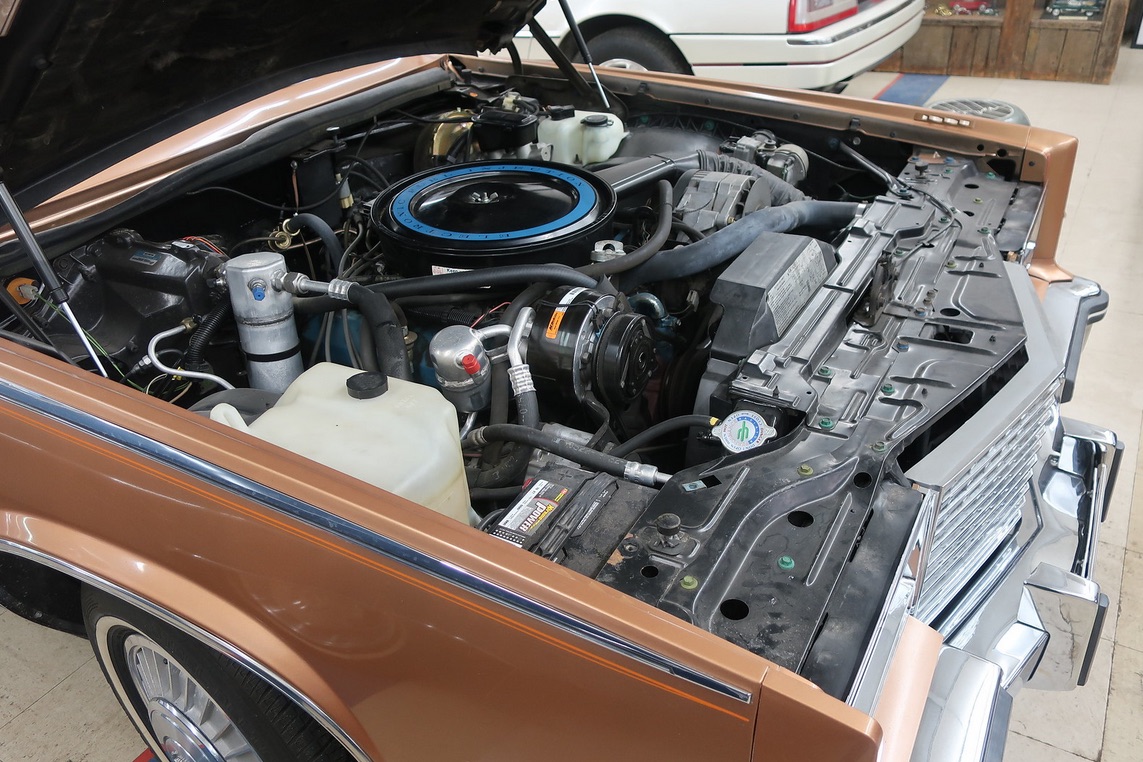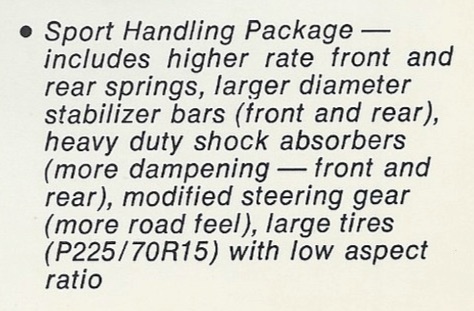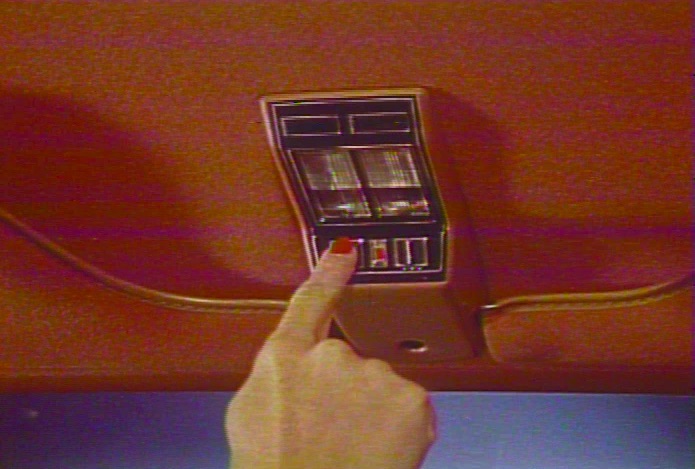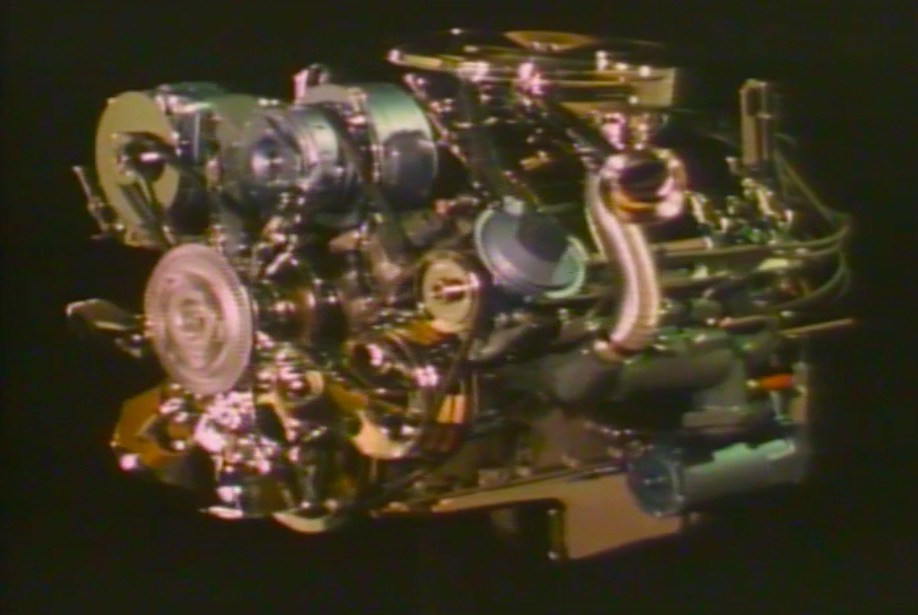DESIGN & ENGINEERING ELDORADO 1979-1985
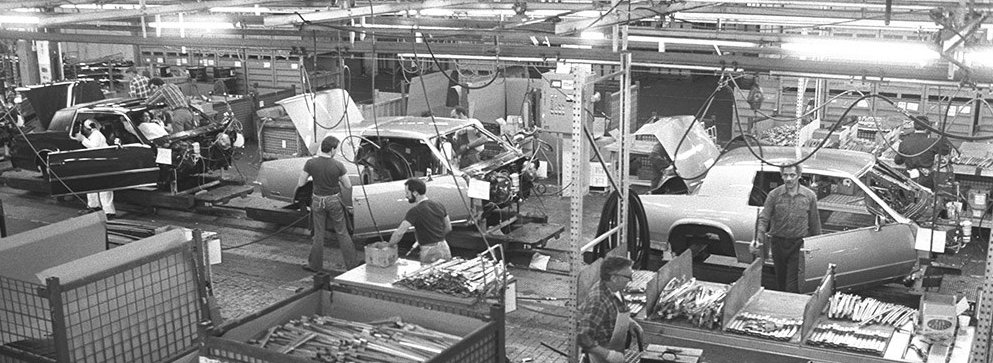 |
|
This section started as an offshoot of the Spotter's Guide, but instead of styling updates, it was intended to capture some of the more noteworthy changes "under the hood". However, I quickly realized a list of bullet-points by year without context really short-changes the true design evolution of this platform. These cars clearly are not "all the same". What follows is rather....verbose, but I think a little understanding of the design climate at the time, as well as constraints the engineers were under is important in fully appreciating how the 3rd gen evolved. Hopefully, you'll find this as interesting as I do. |
Please note, this page is a work in progress, with new info being added frequently. |
It's always fun to look through parts catalogs and service lit on older cars, and the 3rd gen Eldo is no exception. Even comparing to the '79 Fisher Body book, the service manual includes a ton of interesting details that vanished in the '80 publication in the name of brevity. Of course, just about everything in '80 changed for the better. By '84 these cars were pretty much dialed-in with better handling, better insulation, improved assembly techniques, reliable electronics with sealed connectors, and styling quirks cleaned up.
What I've attempted to cover are some of the more obvious high-points. It's not possible to list all of the running changes made; I'm not sure anyone could. The below also does not take into account the many diesel and V6 running changes, nor considers the parallel engineering effort spent on the C/D/K variants which were similar in scope and complexity and competing for the same engineering resources. It would also be interesting to take a hard look at the '80-85 Seville to see if it matured as much as the E-body; it certainly contributed heavily to the '80 Eldo update.
Now referred to as the "malaise era", it's important to understand the factors affecting automotive design and manufacture during the 1970's. The initial push in the early 70's had been curtailing tailpipe emissions, which saw the introduction of a lot of add-on equipment such as A.I.R. pumps, ignition retard schemes, exhaust recirculation, lean-tuning and compression reduction. This generally had a negative impact on both driveability and fuel mileage, which was only exacerbated by the gas crisis in October of '73. It's generally a lot easier to get a small, light weight car with a small, lightweight 4-cylinder to pass emissions AND give good economy. This presented a major challenge for US consumers accustomed to V8-powered full-size cars, though a few MPG here or there hardly bothered Cadillac shoppers. The introduction of the catalytic converter in MY '75 allowed for a modest bump in compression and more reasonable tuning, but MPG concerns were on the mind of most Americans as stagflation spread. It was clear, the "good times" were over.
By the mid-70's, the US Gov't introduced Corporate Average Fuel Economy standards (CAFE) which would only tighten by the late '70s. This obviously hit the luxo-brands the hardest. When the 2nd gas crisis arrived in '79, there was a genuine concern fuel prices would reach $5/gal by '85. Between January 1979 and March 1980, the price for a gallon of unleaded rose 80%.
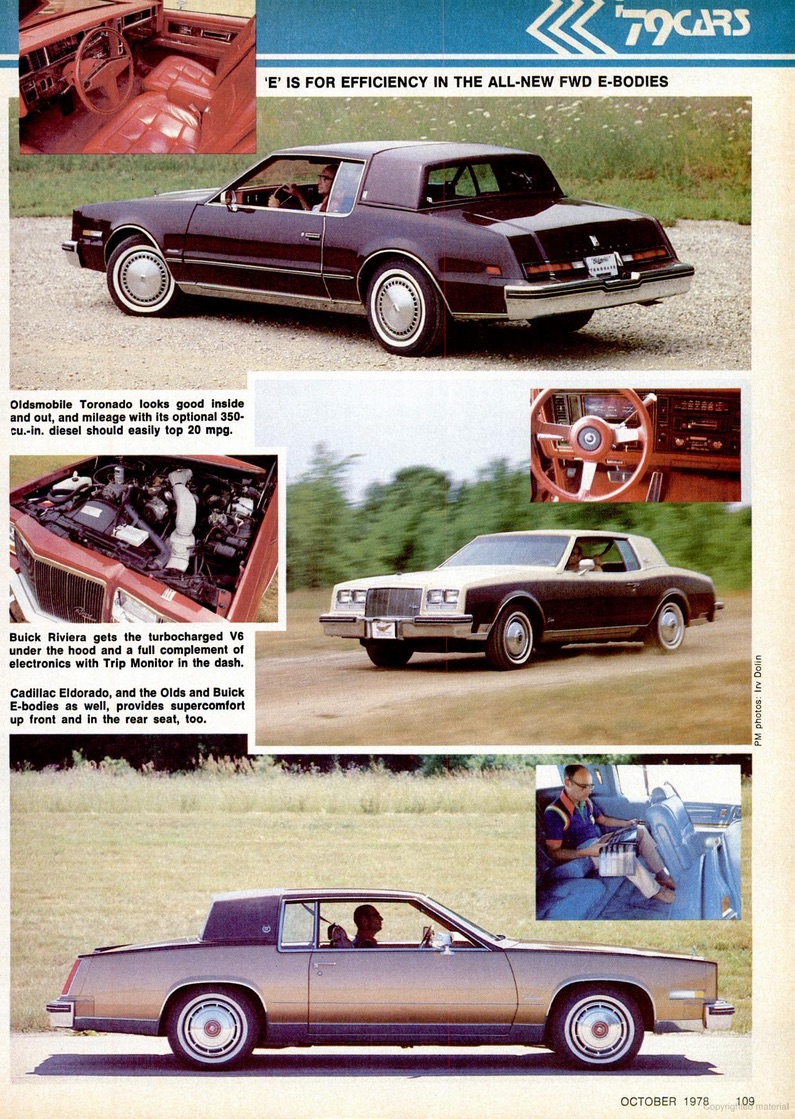 "E is for Efficiency" Click for the full Popular Mechanics Review. |
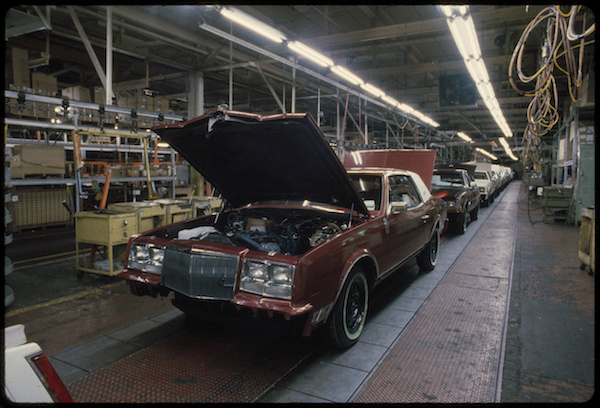 E-Bodies proceeding down the assembly line at Linden, NJ. Note Eldo taillights bottom left. This 2.7M sq ft, 100 acre facility was razed in 2008. |
Now, it's easy to lampoon GM 40 years later for some of their decisions, but they were not sitting on their hands during this time. Besides alternative fuel studies (battery, rotary, diesel, turbine), there were also major programs for weight reduction using new materials and composites, as well as innovative solutions for reducing tail pipe emissions without impacting performance*. The most well-known are the '77 B-bodies, which look big today, but were a significant weight and size reduction back in calendar year 1976. The new '75 Seville, a contemporary-sized automobile (and antithesis of 'bigger is better') also sold like hotcakes. As mentioned above, new alloys were created for strong, but light bumpers. Plastics replaced steel in certain applications which also eliminated rust and corrosion. EFI was made available on Cadillac models where the cost-impact could be absorbed. Aluminum hoods were used on some RWD models. And advancing electronics would allow for a more exact fuel-air mixture with computer-carbs in other divisions in just a few short years. All of this R&D had an influence on the new 3rd gen Eldo, more so in later years once the car was in production and efforts shifted to a continuous improvement mode.
In my opinion, GM had played their cards about as well as one could, and the new generation of Eldorado was no exception. Lighter, smaller, better handling, more economical, more powerful, and roomier (I say this as a guy that owns a '76), it was the total package. Contemporary reviews are favorable, and the public reception was positive.
*I use the term "Performance" loosely. Laughable by today's standards, not everyone wanted (or dreamt of) a 400HP sedan or pickup truck. Pinching pennies was more important to many as inflation rose and gas lines once again entered the public consciousness. Adequate acceleration, a car that would idle without stalling, and decent fuel economy meant more than 1/4 mile times.
| 1979 |
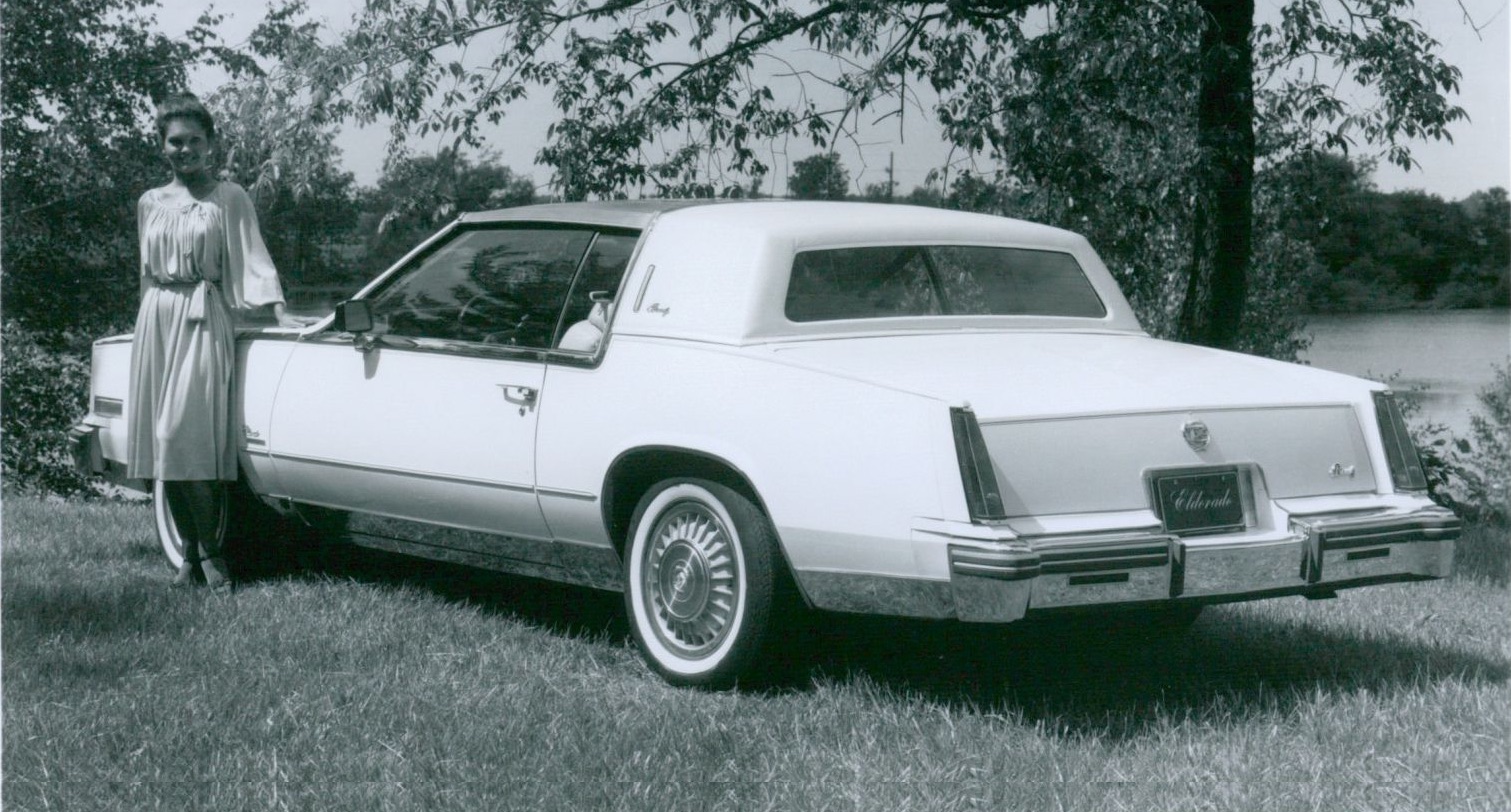 |
The stage is set: 4-wheel disc brakes, 4-wheel independent suspension with front torsion bars, a fuel-injected V8 driving the front wheels, and knock-out styling in the traditional Eldo design language. The '78, despite having 4-wheel discs, had a dead axle in the rear, but word is the engineers had been wanting to bring a new suspension to the Eldo for quite some time. The requirement for max trunk space in the new package made it worth the extra cost.
What the '78 did carry over was electronic level control, Guidematic, Twilight Sentinel, and all of the other goodies you'd expect. However, one of the problems of designing for the future is that you aren't quite sure what might come along by the time you get there. Ever wonder why the 79's have that 'Cadillac' delete plate over the climate control? You could have ordered the Tripmaster* computer to take its place...though at a cost of almost $1,000 few did, and The General would have known that. For the majority that didn't, you got to stare at that plate, along with the plastic rectangle to the right of the radio for which nothing ever materialized.
Now, if you check out the Radio Section, you'll see Delco's first radio with a digital clock debuted for '77, and was quickly replaced in '78 by a fully electronically-tuned radio. These would have been premium offerings for the other marques, and the '77 version was highly exclusive (you couldn't get it on the '77 Eldo, for example). My theory is that the 79's were designed for analog radios, in a time when any ETR was still on the drawing board or production date not confirmed. And if you dig into the GM parts catalog, you'll find a part number for a clock specific to that opening for 1979 that was never released. In fact, all radio offerings for Eldo in '79 ended up digital, though there were improvements made the following year. Incidentally, an Olds B/C clock will fit the bezel, but the mounting ears and lens curve are different. Riv & Toro have unique, incompatible designs as well. As we know, this 'plate' soldiered on for the diesel cars, even after the bezel change in '84, but IMO sticks out like a sore thumb.
Speaking of designing for the future, new computing power and techniques allowed optimization of NVH with regards to engine bracketry, engine mount design, chassis design and spring rates. And the diesel program meant significant study of noise isolation which would carryover to the gas models later on. It's a solid reason you shouldn't replace rear springs unless you have to; the originals are tuned to the chassis.
| *The Tripmaster computer was an extremely advanced effort first introduced on Seville in '78, interfacing with the Olds analog ECU. For '79 it was redesigned with a number of improvements, and shared with the Eldo, however Eldo had vacuum fluorescent displays that also made it unique to the E-body. Consider that... Seville used one version for 12 months. And Eldo/Seville used the new version for another 12 months but with unique displays. That's it. Proprietary parts for one model year each and at a premium price (possibly loss). I'm sure the bean-counters loved that. YouTube Link HERE. | 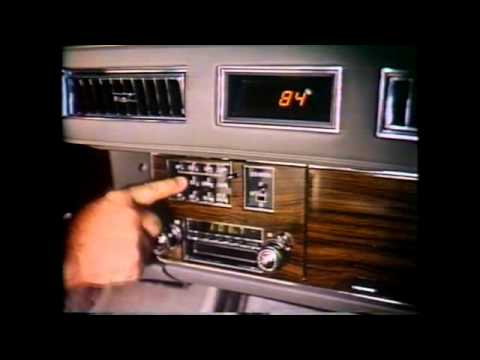 |
From a collector-car view, if you want a “pure” 3rd gen Eldorado, the '79 is definitely it. Systems are independent and risk mitigation (at the time) meant using as many “proven designs” as possible, no matter the level of refinement. The analog-dial automatic temp control is unique to this year, but is actually a carryover 77/78 design. The windhshield wiper system is also a carryover, and even though the switches appear the same '79-'85, '79 is electrically unique, internally. The Olds 350 engine with analog EFI is robust, having been proven on the 1st gen Seville even though DEFI was being readied in the background. For the Eldo, the FI harness is integrated into the dashboard wiring, but has an independent firewall connector (whereas '75-'79 Seville uses a 1-piece harness direct to the ECU, independent of the body). In CA where the cars had to meet more stringent emission requirements, a 3-way catalyst exhaust system and closed-loop ECU with O2 sensor (and modified speedometer) were used. Check out the Speedometer page for further detail.
The transmission is the THM-325*...a solid package using the proven THM-425 approach, with downsized RWD components (spinning in the opposite direction). The 4-speed would come later with the 4.1L Buick V6.
Cruise control was a carryover of the '77 design unique to Cadillac. Running gear, options, interior appointments are well thought-out and trouble-free. And if you know these cars, many interior components are specific to this year, or carried over to '80 and dropped...and not just the 1-year only birdseye maple wood grain panels, but electrical and mechanical underpinnings. For '80, Cadillac themselves declare the model-year revisions as major a change as the '79 design itself! That's saying something.
| *Consider this...The THM-325 was only used by the E-cars for 36 months, and the Seville for 24. That's it. With different final drives, and modifications if you ordered the diesel. And the 4-speed appeared in '81 for the V6 option, so it was clearly under development within 24 months of the 325 release. Crazy. |
Now, if it seems like I'm knocking the '79, I'm not. It's a damn fine car with significant R&D. Very few areas were left untouched as cars got smaller (where to find interior space?), diesels got popular (noise and vibe concerns), gas prices skyrocketed (MPG efficiency), tailpipe regs got tighter (especially in CA), foreign imports encroached (resale concerns, rustproofing, fit and finish and corrosion became tantamount). And inflation ran wild...(how to not price-out of the segment?). The luxury segment was hit hardest.
I've found several SAE papers that give a brief insight into the R&D work going on at CMD at the time in an effort to tackle these problem areas. This paper on Dual-Phase Steel Bumpers for the Eldo is but one example. If you're so inclined, I recommend you check it out, it's an impressive proposition. Developing a new steel that was ductile enough for the complex geometry of the '79 bumper, meet gov't impact standards, provide a finish traditional customers expected, and yet reduce combined front and rear bumper weight (over '78), ultimately by 52%!
Additionally, there was a significant goal aimed at improving corrosion resistance, which introduced plastic fender liners, including molded-in battery tray (the big Toros were plastic, but not the Eldo). 2-piece fenders with wax liners, gasketed ornamentation, dual-metal wheel opening trim, plastisol application to door and body seams, and a zinc-rich primer dip before paint.
 Note extended studs for '79 trunk pull-down. |
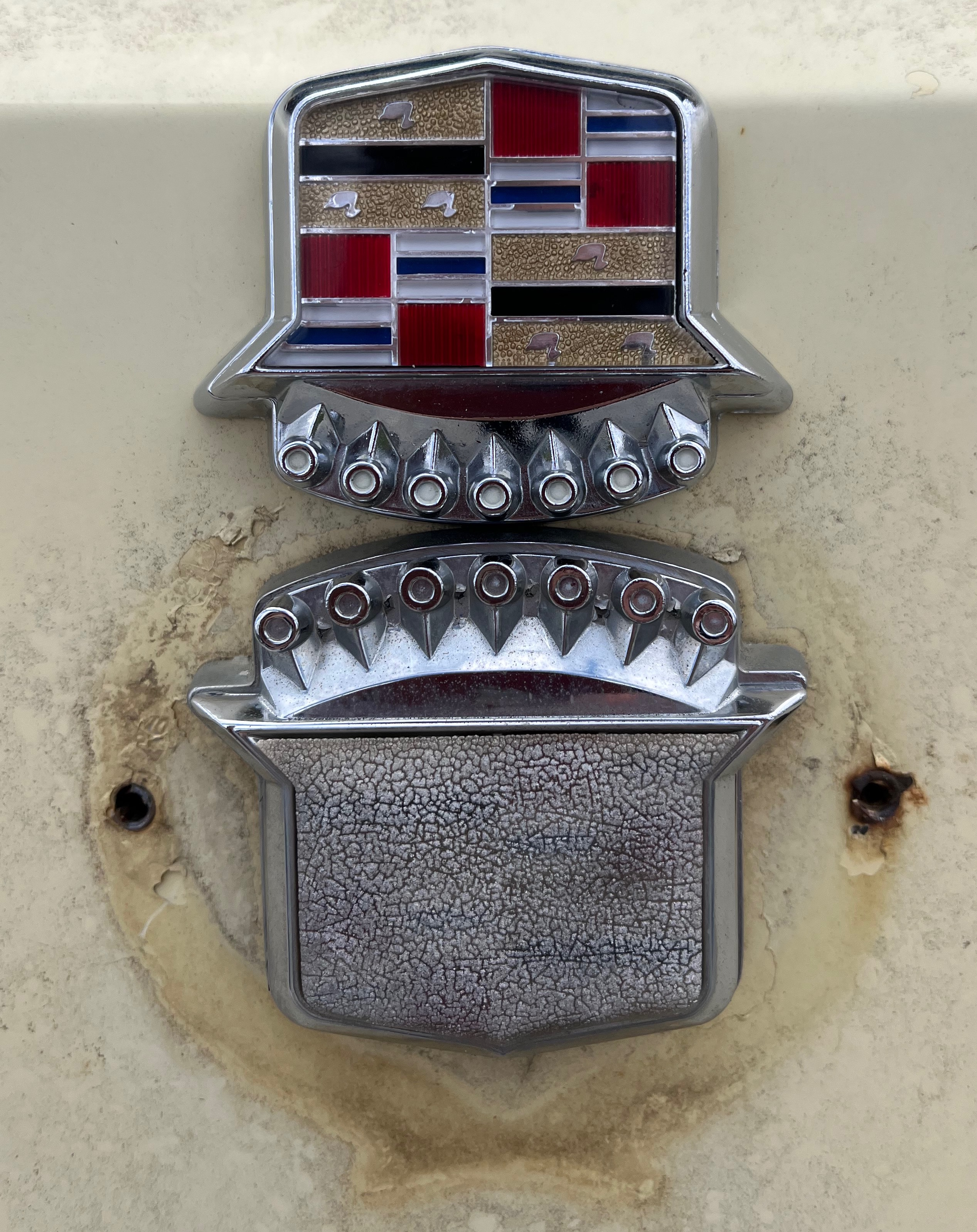 Example of unique W&C sizes along with pins. |
Being a 1970's design, the '79 (edit: and at least some '80 examples) use punched holes in the trunklid to capture emblem studs (and accompanying access cutouts on the inside of the decklid to reach said holes). In fact, the decklid wreath is a casting like the old 70's models. This changed when adhesive backed emblems were introduced. The parts catalog is rather vague...'79 is one part number for W&C, '80/81 breaks them up, and '82-85 a third design. 1979 is the only year for the old style space saver spare that uses a bumper jack, wooden chock and a gas inflator cylinder. And like the big cars, the trunk pull down is cable operated with the motor mounted remotely to fender extension studs on the right hand side behind the trunk lining. The door insulation is the old style compressed waste-thread. Electrical connectors are first generation sealed types. Having analog EFI, dash wiring is unique, as is the fuel line routing, fuel filter (canister type under chassis!) and tank pickup. And considering the interior, a majority of the wiring is unique to that year, including the door controls. All of this would change the following year.
Under the hood, the ALC compressor has a bypass Schrader Valve, the front header panel is steel, and used through '81, along with separate left and right headlight bucket assemblies. But a top-mounted header plate unique to '79 prevents any access to the back of the headlights or park lights from above. It's also the only year for plastic splash shields to bridge the gap b/w headlight trim and the header panel (see pic below). While we're at it, the bumper impact requirements of '79 lead to a 1-year-only spring loaded grille that moves with the force of the bumper; the grille became fixed in 1980.
Note that the 1979-81 cars use a heavy mix of SAE and metric fasteners, including those used in the interior and dash; this would change for '82. The interior was also extensively overhauled for '80 and you can find details in the Spotters Guide.
If you ordered a diesel, there were also significant differences from the gas model, some of which eventually were adopted on the gas cars later on, such as hush panels being installed under the dash, and use of semi-metallic brake pads. The '79 gas version has none of that, with wiring, ECU and fuse block exposed. In fact, the under-dash courtesy lights mount directly to the steel substructure and have connectors that plug into the dash harness. Later these were integrated directly into the harness and mount to the hush panels.
The EFI 350 soldiered on into '80 on the CA-spec cars (adding an O2 sensor) with no real changes to the trans or final drive. However, the CV axle assemblies were revised mid-year to a new “tri-pot” design. All this in addition to the “regular” continuous-improvement projects for the Eldo that improved ride, reliability and added new features. And keep in mind, the all-new 1980 Seville sister-car was being readied for release, too; a clean-sheet design, it was one of the most advanced cars (engineering-wise) Cad had ever produced up to that time, and the Eldo greatly benefited.
| 1980 |
 |
You might think of the '79 as the opening act. It was a strong sales success, and was proof Cadillac was on the right track. GM wisely waited until '80 before unleashing some pretty radical tech on the car. They tied with Lincoln* on introducing the very first digital fuel injection system in the industry (world-wide). Not just microprocessor controlled fuel metering, but interactive onboard diagnostics, fail-safe substitution of parameters if a sensor or connection failed, software updates via replaceable PROMs, spark and idle control, all coupled with a brand new Electronic Climate Control system....and the first appearance of the “Check Engine” light.
| The new L61 DEFI engine was the last of the cast iron CMD designs, being an indestructible debored/destroked 500. 50 pounds lighter than the 425, it was fitted with an aluminum throttle body with dual injectors with a low pressure fuel system, under closed-loop control, of course. Under-hood connectors finally come of age. [For more on the DEFI setup, see In Defense of DEFI here] |
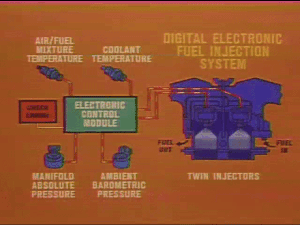 |
| *Even die-hard Lincoln fans will admit Ford's "new for '80" EEC-III system was not ready for prime time. The design had a nasty habit of operating overly-rich as components wore in (no parameter bounding) and the majority of ECUs were replaced while still under warranty due to other failures. Fuel pressure was still the old high-pressure 40 PSI setup. Diagnostics were laughable compared to Cadillac, having no I/O other than the sensors and actuators on the engine. Thus to get into service mode, one would run the engine to get the O2 sensor up to temp, quickly drop off of fast idle, then apply vacuum from a hand pump to the MAP sensor and hold for 10 seconds. Once idle increased, this was your signal to dump vac. You now had to monitor two solenoid wires with a pair of voltmeters and “count the pulses” only when each meter agreed. Heaven help you if you missed a pulse and had to repeat things. The dealer-only test box helped some, but there was no 1:1 interrogation like the Cad system. | 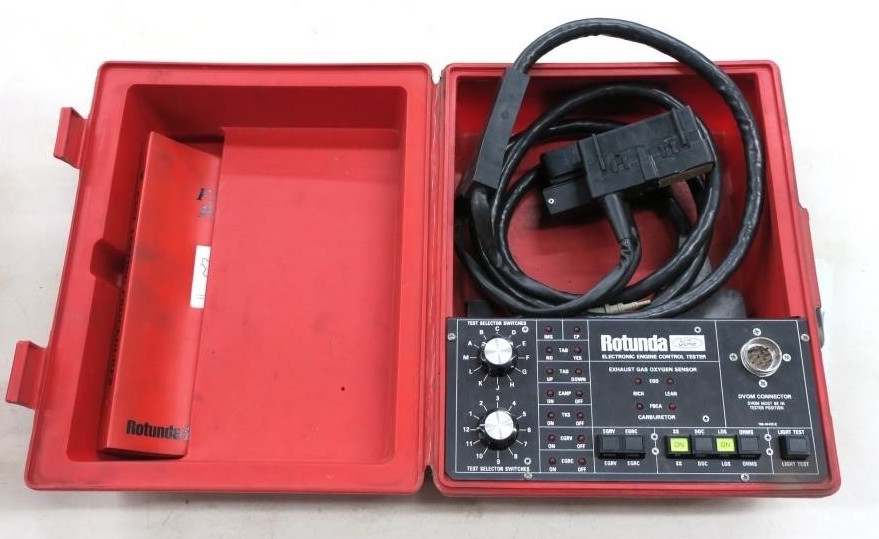 |
To accommodate the 368, you had a bevy of new FWD-specific components including brackets, mounts, exhaust, etc. along with a FWD pan/pickup, fuel lines and pump and a new RH output shaft. The RWD cars also got the 368 but with a 4-barrel CCC system, and were able to use a lot of the old 425 architecture. The 350 diesel was still an option, and was standard on the Seville. Again...different tank, different pickup, different lines and routing, different exhaust, modified trans, different final drive ratio, glow plugs with dual batteries, heavy duty cooling and charging, and lots of sound deadening added throughout the car*.
| *Why not commonize and use the same sound deadeners on both gas and diesel versions? The fact of the matter is that weight was still a concern, and if I recall, the diesel cars had double-digits worth of weight added to keep out the diesel clatter. There may have been some cost savings, too, but consider those awful gas struts used on the hoods and decklids. Certainly more expensive than a torsion rod or spring, but CMD considered it was worth the cost to get the weight down. |
Spring rates and torsion bars were revised over '79 for an improved ride, and were also specific to drivetrain. The standard suspension was reduced from a rate of 38 to 36 while the diesel remained at 40 through '81. Along with most other GM cars, the springs remained computer-matched. Speaking of suspensions, the popular Touring Suspension package would not appear for another year, but an obscure “Sport Handling Package” was newly available that gave you essentially the same thing- higher rate springs, torsion bars, shock valving, gearbox feedback, and P225/70R15 tires...same as Corvette. And speaking of tires, you could now optionally order Uniroyal's self-sealing puncture resistant "Royal-Seal" tires; capable of "permanently sealing" punctures up to 3/16" in diameter. Even if you didn't spring for those, the standard 215/75R15 offering was a new design with reduced rolling resistance to help with fuel mileage. This improved tire compound was shared across GM divisions in '80.
While it may not seem like a big deal, the Delco Freedom II battery was introduced on the 1980 models and featured a 33% increase in grid wires, a 68% increase in current, a higher amperage rating (460A), and was physically smaller than the old fashioned '79 style. It recovered quicker from discharge and had a greater reserve capacity. Diesels got a bump to 540A with the new Freedom II.
Inside, the interior saw some big changes (see the Spotters Guide for full details). The birdseye maple was out, but so was the Tripmaster. In fact, there was no digital speedometer offering for '80, but a new MPG Sentinel was mounted above the ECC head, and showed instant and average fuel economy on amber LEDs; Range would come later. Of course, the new ECC meant a re-design of the airflow and mixing behind the dash. The '80 programmer is the only year in which the defrost function and recirc door can be controlled independently. How the ECC software made use this, I don't fully appreciate, but they were later combined for '81. It's also the only year to run the blower at a fixed low speed when the system is set to OFF to circulate fresh air through the interior.
Digging further into the ECC, this was the introduction of the variable speed electronically-controlled blower motor, operated by a solid state module on the airbox. The ECC head sends a command to the module for blower speed, as well as A/C compressor control, and the module handles the power. The programmer still uses an on/off signal from a bi-metallic heater switch like the '79 design, but this time no electro-mechanical parts are involved.
| It may seem quaint these days, but digital climate control was a pretty big deal in 1980, and Cadillac was first. Lincoln had cheapened their auto-climate system in the late 70's, reverting back to manual blower control. And the "luxury imports" were still pushing rocker switches and analog dials, and would do so for another half-decade. Contemporary Mercedes CC at right.....Yikes. |
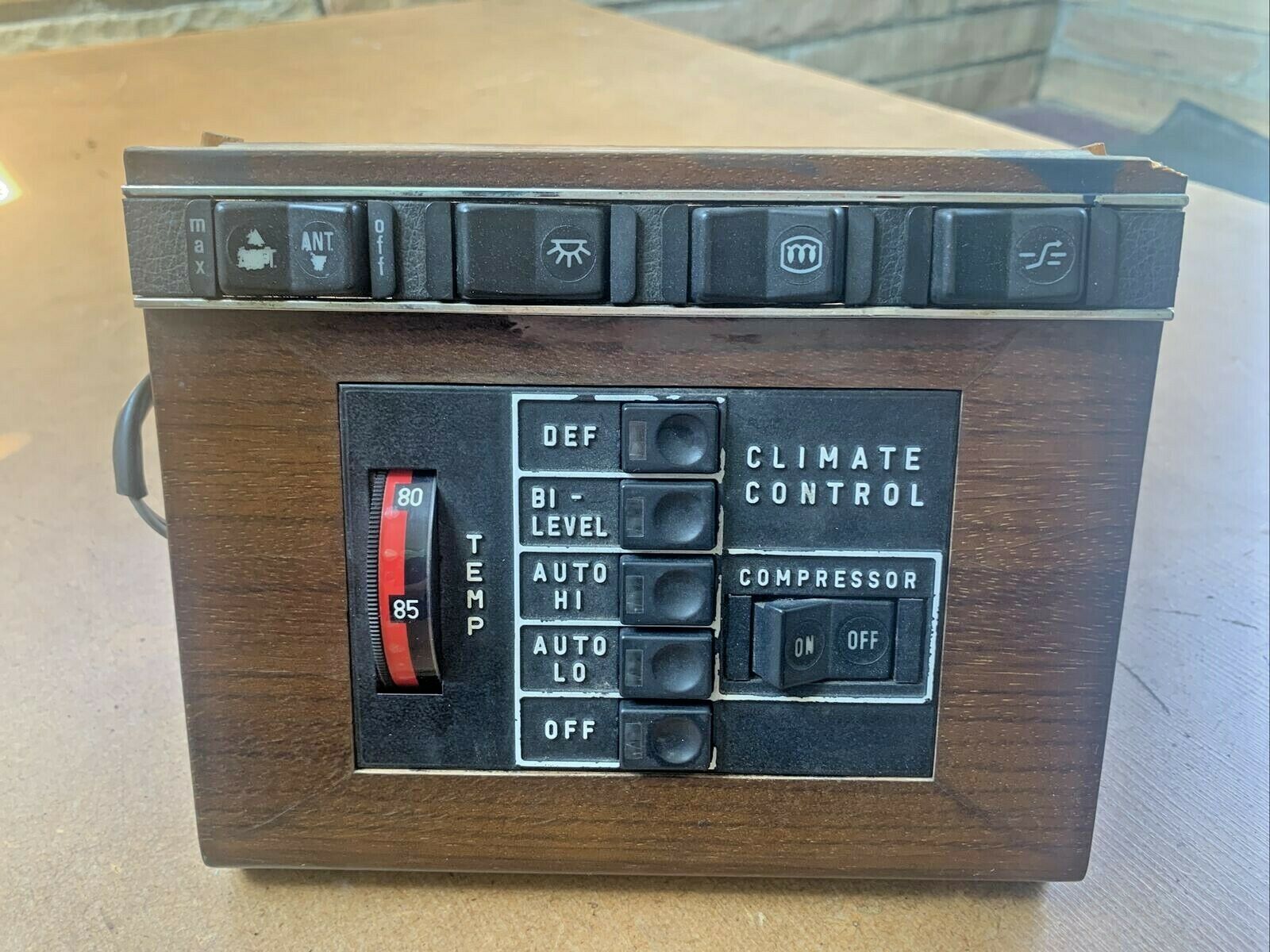 |
As touched on previously, '80 brought forth adhesive-backed exterior emblems and trim to combat rust, and saw further improvements in primer and zinc coating. Designers also took this opportunity to rescale certain parts, like shrinking the trunk crest by a 1/4”, and changing the wreath from a 3D zinc diecast part to chrome-plated pot metal (the back needed to be completely flat for the adhesive). Besides a styling change, the new grille becomes rigidly mounted and the accompanying side trim was changed. The trunk pull-down becomes fully integrated with the latch (no more cable). The old style spare and jack get replaced with a donut and scissors jack. Someone gets wise and changes the header panel plate design so you can get to the back of the headlights from above. A new cruise control system is introduced which uses a separate module like the old design, but does feed speed info to the ECM; the dash switch is revised to a simpler on/off config. To help with fuel economy, an air dam was added under the front bumper and used through '85.
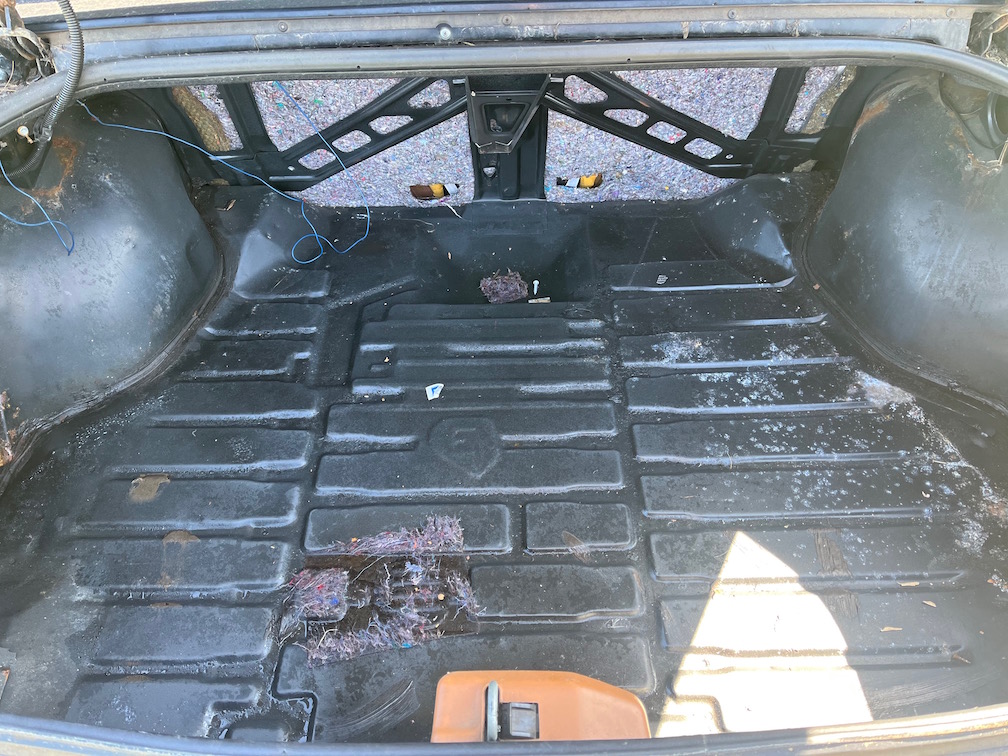 Along with the change to a donut and frame-rail jack, the mounting brackets were changed as well. Compare to the '79 pic above. |
Heated rearview mirrors are available for the first time, and actuated with rear defrost. This makes for 7 -different- mirror variants with/without power control and optional thermometer! Inside the door, wiring has changed for a new power lock system, controls rearranged on the door for easier reach, and lock pulls changed to be more 'anti-theft'. The corporate dome light and wiring is now gone, and the new Cadillac map light with integrated visor support makes its first appearance. This includes that little flap-door we all know and love, to accept power accessories like a new garage door opener that can be programmed for 3 different doors/gates. The idea behind the removable opener is that you can swap it between cars, or even use it with an available battery-powered slip case (ex. open remote gates, hand-off to grounds-keeper, etc).
Unlike the old style carpet in the '79, 1980 uses a new bonded-rubber "mass-backed" carpet that conforms to the floor pan and makes for an even quieter interior and holds up better to wear and bunching. From '79-'85 two different carpet piles were offered, with the Biarritz getting the plusher Tangier/Tampico version. This also extended to the lower door panels, kick panels and waste bin, in every color offered for each year.
If you ordered a Biarritz, the power seat mechanisms were different, making '79 1-year only. The new mechanism was a tri-motor design making extensive use of aluminum for the chassis. Not only is it lighter and just as robust, it's also quieter in operation (no clunking solenoids). This same setup was used on the ETC bucket seats, and Seville. Of course, this meant different wiring and controls just for Biarritz. And speaking of quieter, somewhere along the line Cadillac changed from waste-thread door insulation to die-cut foam. My hunch is this happened in '80, but I won't swear to it, at least not until I get my hands on an '80 to part out.
In the appearance-department, the dashboard, door panel, seat-back strap ends and even rear dome light woodgrain was changed, giving a more modern appearance to complement the new ECC and revised speedometer. For Dash Updates, see the Speedometer History section.
For 1979, the Riv & Toro appear to have shared door armrest controls (Toro had a burl applique) while the Eldo got a shorter length control panel, but same control layout. For '80, the Lock and Window switches swap position, and inner door wiring was changed to accommodate. It doesn't appear that this change carried over to the other sister cars. If you ordered the auto-locking door option, '80 now controls the driver's door independently, unlocking only it when you shift into Park. Theft Deterrent, offered on '79, now includes a starter solenoid disconnect.
 |
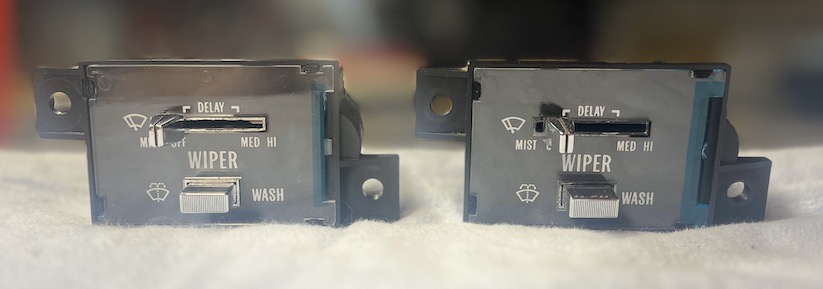 |
| Which is Which? The wiper control was updated for 1980 and remained unchanged through '85, making '79 incompatible. In GM's wisdom, these controls were never marked with a part number to differentiate them. |
Like I said, pretty much everything under the skin is different from '79, and while the '80 does use a lot of unique parts, it's a significant step-up over the prior year's model.
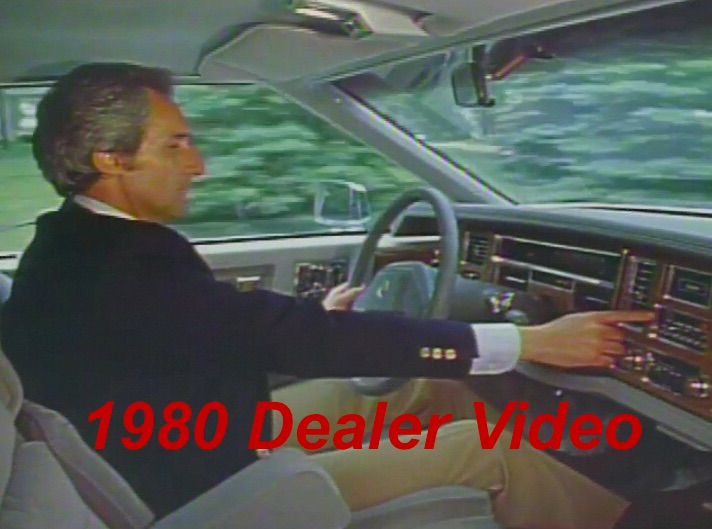 |
| 1981 |
While 1980 turned the car on its head, 1981 was a natural progression of the '80 components with one major exception....the L62 V864 Engine. Actually, it's not just the engine, but everything associated with making it work. There's more detail in the In Defense of DEFI section, but essentially, this is the tried-and-true 368 with four valvetrain solenoids that mechanically bypass valves, allowing operation as a V4 or a V6 when active. Developed by Eaton, when disconnected, the valves remain closed, reducing pumping losses. 8-cylinder mode is used for getting underway, 6-cylinder is intended as transitional, and 4-cylinder is for cruising under light load when the trans is in high gear. Disconnect the high-gear wire, and the system always operates as an 8.
Since powering solenoids takes a pretty good amount of current and would put a severe strain on the electrical system, a separate modulated displacement controller operates the solenoids much like a peak-and-hold fuel injector, hitting the coil with full voltage, then pulling back once the magnetic field is established so that only minimal power is required. The valves remain inoperative so long as the engine is being commanded for 4 or 6 cyl mode; no sync or 'refresh' is necessary.
| In my personal opinion, this engine gets maligned far more than it deserves, possibly because people are confusing it with the HT4100, possibly because of 'wives tales' far disconnected from any ownership, or simply because it was only offered 1-year and must have 'not worked'. | 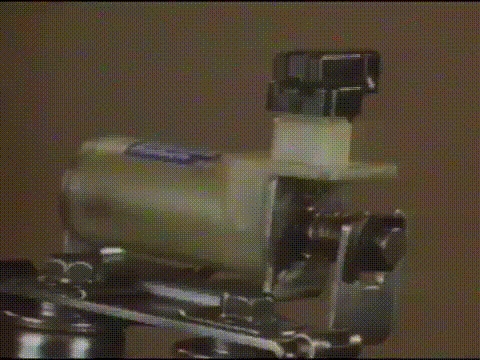 |
I have read (more than once) in contemporary articles that the electronics weren't “fast enough” to keep up with system demands, but can find no proof that this is true. In fact, it doesn't make a lot of sense considering how the valves are cycled, and how operational overhead would be no more taxing than locking and unlocking a torque converter.
As for why the system only lasted a year? My understanding is that the NHTSA and CMD couldn't reach an agreement on what MPG ratings were for the engine (duty cycle in each mode under customer ownership), thus negating the entire engineering exercise*. In fact, the V864 continued on in the commercial chassis' where CAFE rules were different. In the end, this was for the best as operating a V8 with dead cylinders did create a vibrational imbalance that was noticeable to customers, and contemporary reviews indicated that fuel economy was really no better than the '80 version, especially when you're intentionally putting your foot into it to keep it running on all 8.
|
*The Cadillac Division was doing -everything- they could to get their corporate avg fuel economy up. Case in point: Diesels, a V6, and the 1982 Cimmaron. Now, they could have also paid the CAFE fine on every vehicle, but what drivetrain would they have fallen back on that would also meet emissions? With regards to V864 CAFE-specifics, check out the Motor Trend article below. |
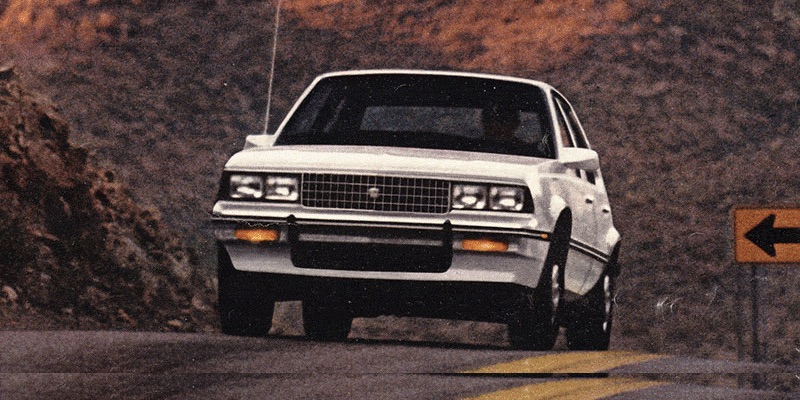 |
In addition to the V864 and a new MPG Sentinel that shows active cylinders in real time, there was some other big news with the onboard computer. Processing power was up 100% over 1980, program memory was up 50% (12k-words with 2k RAM). There were 23 new trouble codes bringing the total to 47, along with the ability to monitor 11 engine parameters in real time. Many engine sensors were also improved or revised over '80, which does create a bit of a 1-year-only problem.
A digital speedometer was now available with corresponding digital fuel gauge and a range display. If you ordered the analog dash, range is displayed on the MPG Sentinel, calculated by a separate range computer (1-year only). The DEFI computer now includes logic for the cruise control (and takes speed input from the speedo cluster). And while the turn signal stalk may look the same, the switches are now normally-open instead of normally-closed due to the system change.
The climate control also appears the same, but the blower module, control head and programmer are all different. The interior ambient sensor is also new, and this year when the ECC is OFF, the blower is completely OFF rather than low speed for ventilation.
As usual, both the radios and the speakers improved again; power was bumped to 12-watts per channel and a new automatic loudness circuit was added to the AM band. New antennas which are rubber-isolated and have environmental RF connectors are used on both Eldo and Seville.
If you ordered Guide-Matic, “Flash To Pass” is now built into the system. And a memory-seat option is available for the first time since the 1958 Brougham.
And of course there were the usual interior changes...new door panels with spring loaded handles, elimination of the rear passenger interior handle. A unique 1-year-only dual comfort seating arrangement in front (45/45 with lowboy console) and a new steering wheel design round out the interior changes.
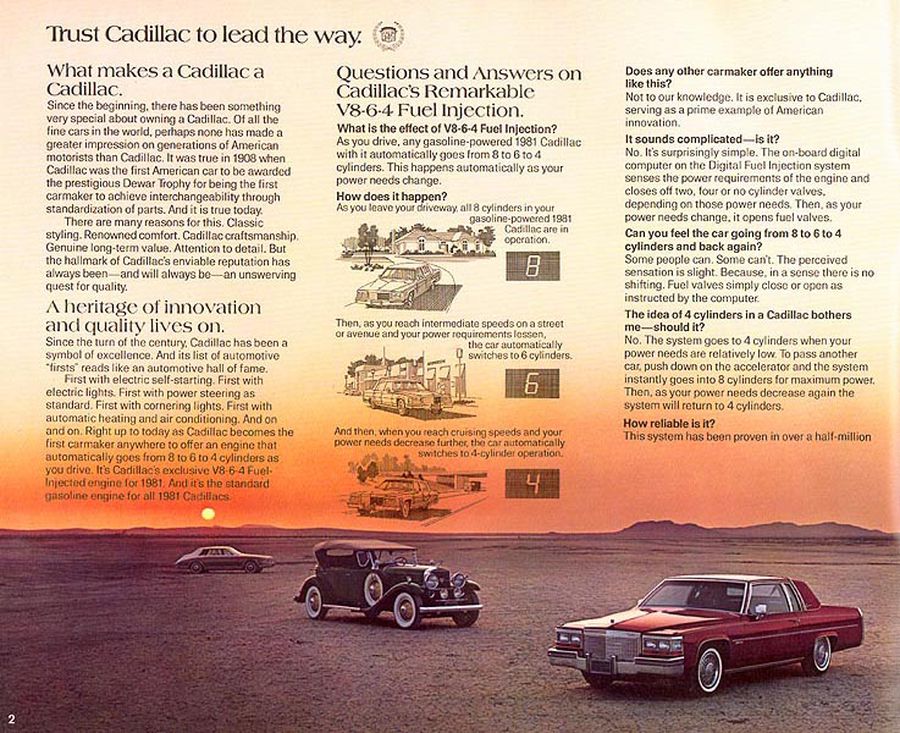 The V864 System |
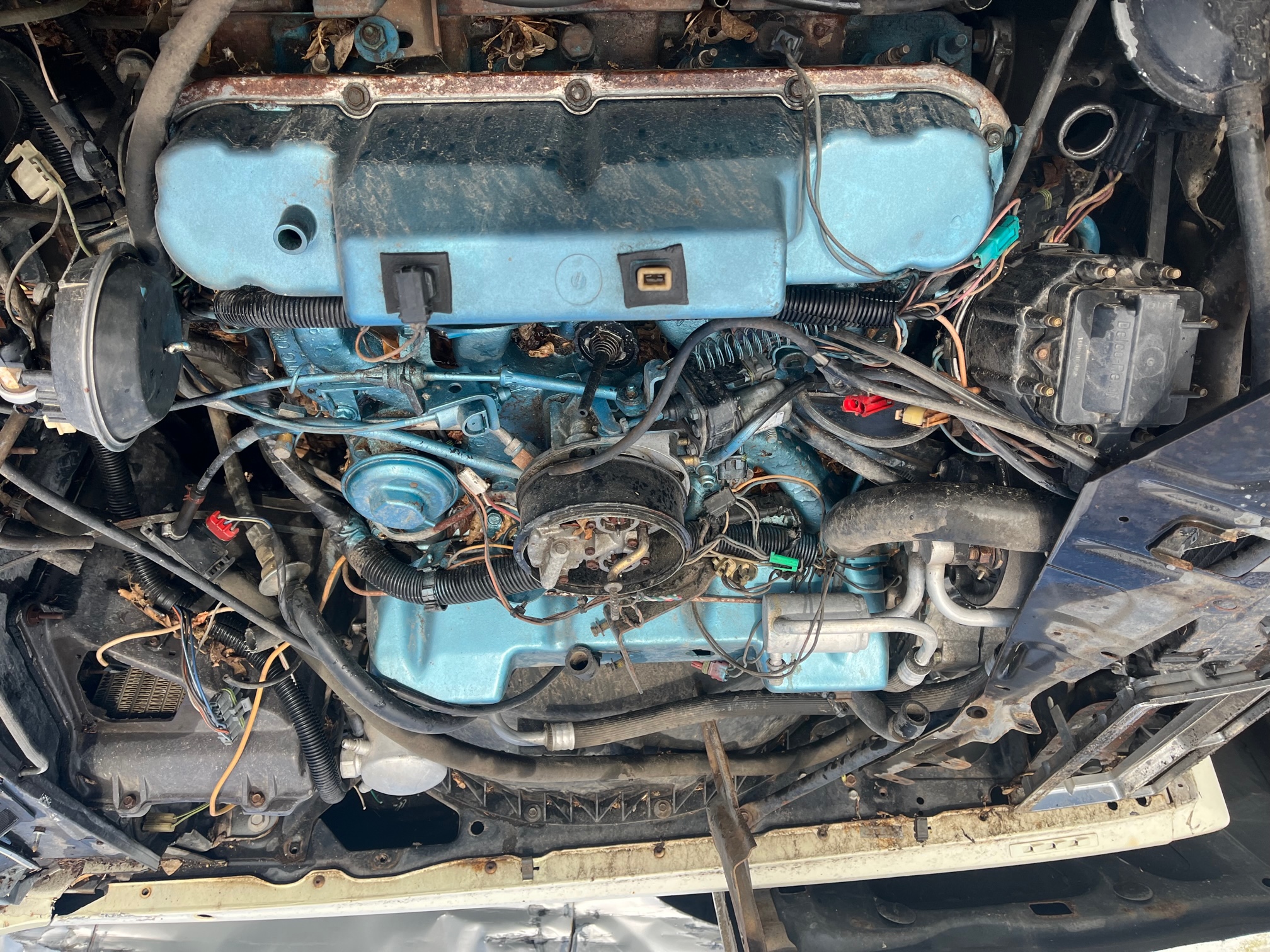 Note composite valve covers housing cylinder deactivation solenoids; connections at top. |
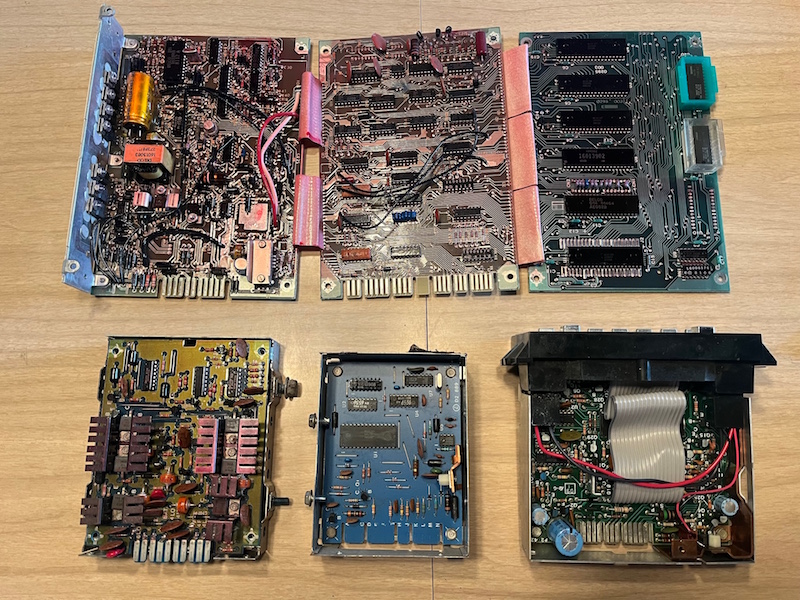 Top: DEFI ECU Unfolded. Bottom L-R: MDDA Driver, Range Computer, Climate Control |
While the GM parts catalog specifies a common part number for all 1979-85 hoods, the underside stamping is clearly different, having an '81' stamped into it, along with front fender-to-header brackets. I took a tape measure to a '79 and an '84 and found a 1/4” difference on the “flats” flanking the coffin nose between the two. The grille header did change by a 1/4” on each end, but strangely, not until 1982 (perhaps the stamp refers to calendar year '81). A light mounted to the underside of the hood is new for '81, and positioned above the oil dipstick.
New cast wheels, new wire hubcaps and a unique (never seen) adhesive-backed accent moulding was also introduced. Plus the usual styling updates. (More in the Spotter's Guide).
The Sport Handling package evolves into the FE2 “Touring Suspension” package which continues through '85 and proves popular.
In addition to the V864 and diesel, the Buick 4.1L V6 is now offered, mated to a new 325-4L transmission with lockup torque converter. This engine is carbureted, meaning a whole different set of engine mounts, brackets, fuel lines and electrical architecture is needed. At least the V6 could use the diesel-spec climate control components which operated independently of an ECM, though those parts would also be new for '81 considering the other ECC changes.
And that's only the half of it. New options, new tech, and overall refinements make the '81 a much-improved car over the 79's. But there's something interesting in the works....
 |
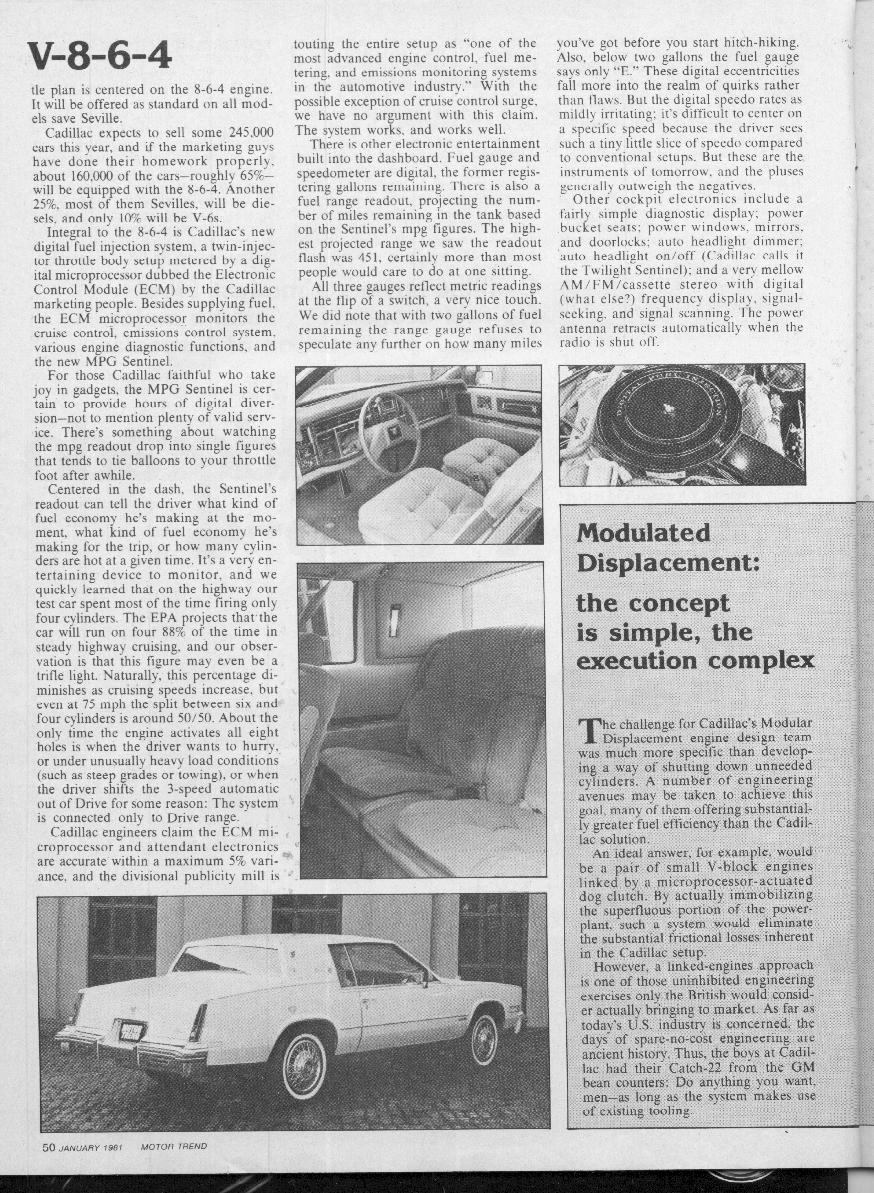 |
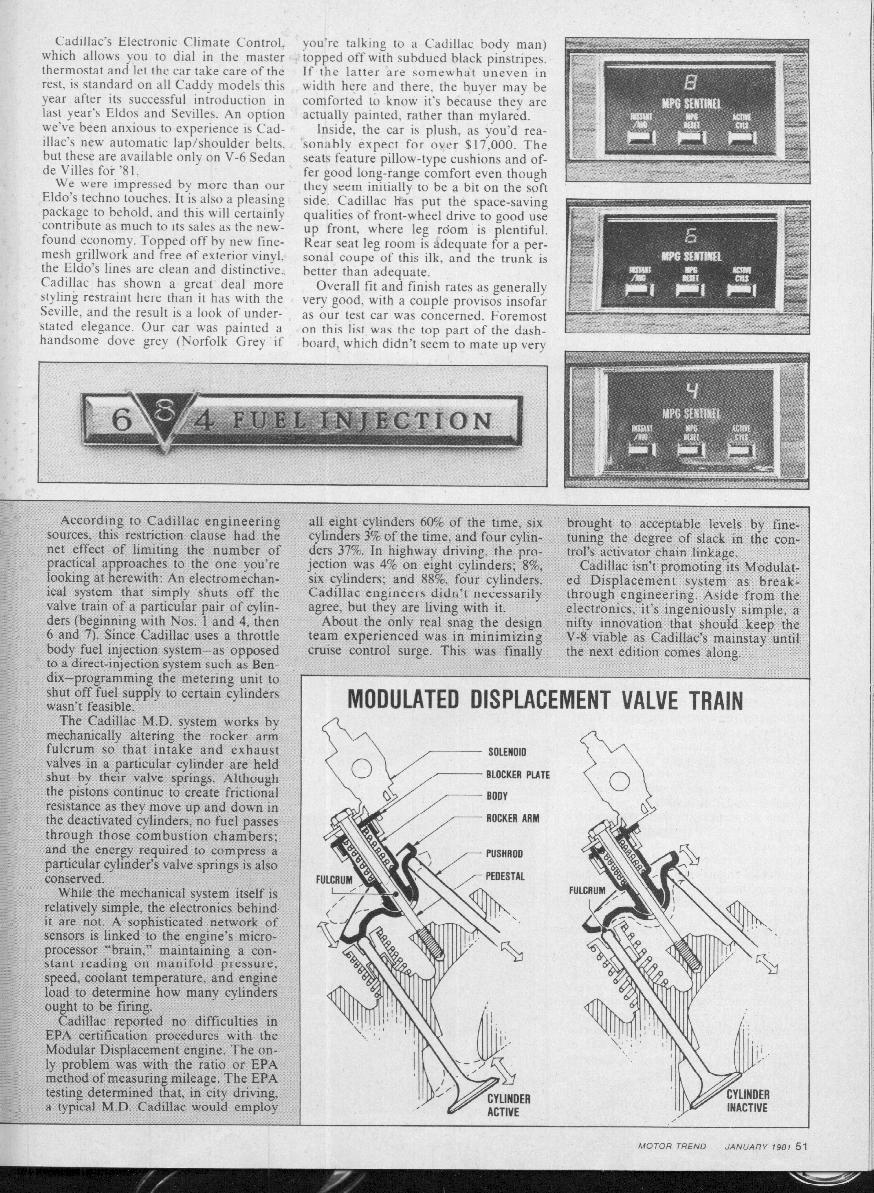 |
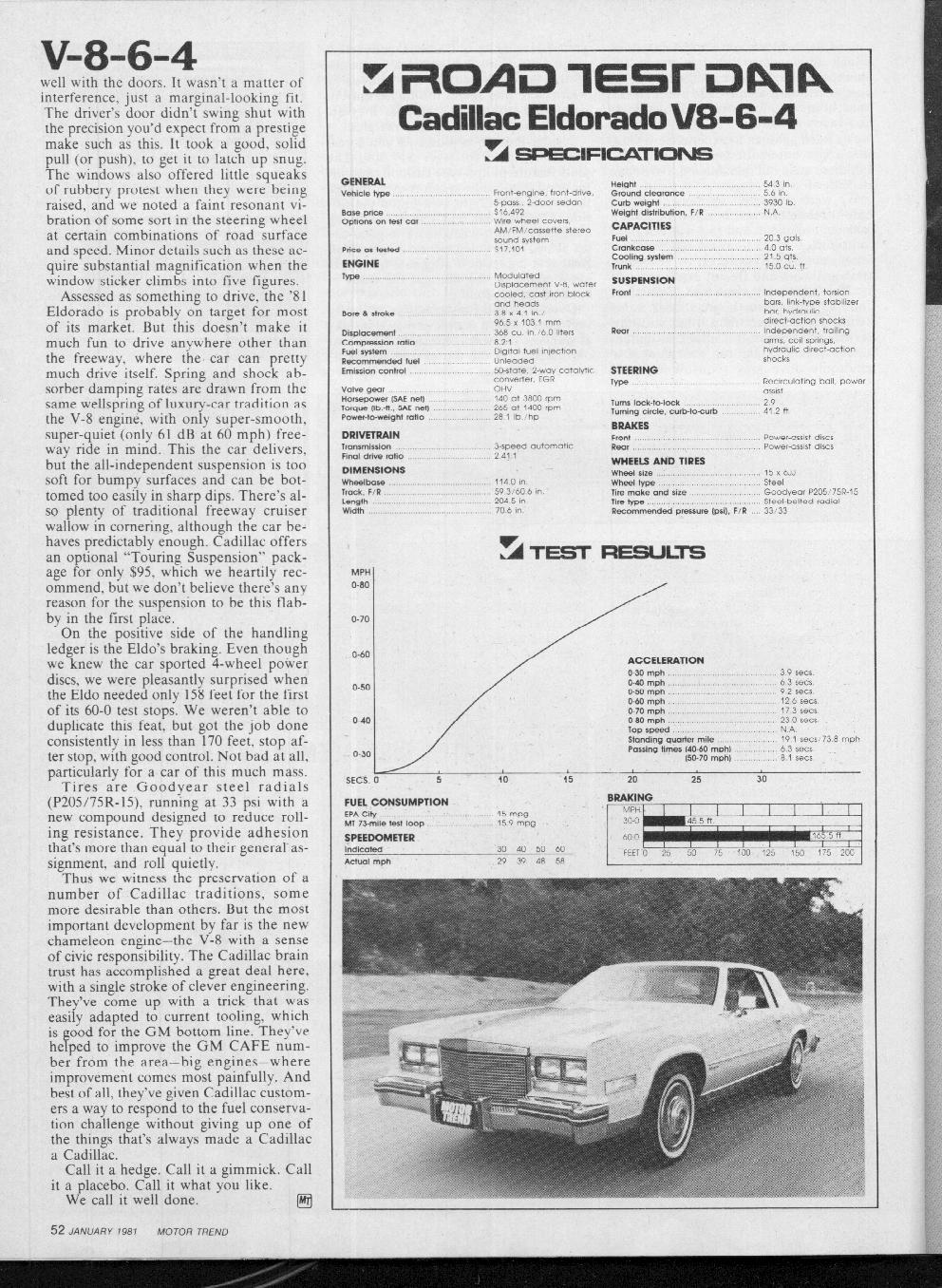 |
Note: Two different generations of ECMs (and PROMS) were used. Gen 1: 600001-616866. Gen 2: 616866-690461.
A Buick 4.1L V6 was available as a $165 credit. That makes a diesel, a DEFI, and a carb'd drivetrain (and all associated mechanical changes) available.
 |
A Random Thought....consider something seemingly straightforward, like checking the Diesel box on the order form of your new 1980 Eldorado. Besides the engine and bracket changes, the transmission and final drive are modified, the electrical architecture on both sides of the firewall are different. You have a different exhaust and emissions system. The fuel tank and sending unit are unique. The suspension is different to account for the weight. The climate control and cruise system changes because there's no ECM. The interior is modified with additional sound deadening materials and under-dash hush panels. The cooling system is changed. The charging system is different, with two 12V batteries to handle the glow plug system as well as (new) line heaters, glow plugs and a heavy-duty alt. The speedometer changes for the tell-tales and fuel gauge, as does the supporting wiring. And on, and on. And all of these changes are also tweaked year-to-year. And oh, by the way, there are 3 different engine options in '80 when you consider CA-spec! And 3 more again in '81 (new V6, new V864, DX Diesel). Might as well be a unique model by today's standards! |
| 1982 |
Failure of the V864 to improve CAFE numbers in '81 meant Cadillac was in a tough spot. The division had been working on a new, lightweight, compact, sophisticated aluminum V8, intended for transverse installation in their upcoming downsized FWD models. That was still a few years off, so in desperation, the design was re-worked for longitudinal mounting and dropped into everything from the Eldo to the RWD Fleetwood. This crash program had predictable and unpredictable results...it was obvious 125 HP wasn't enough to lug around a full-size Cadillac. But soft cams, head gasket failures and leaking cylinder liner o-rings caught many by surprise, especially considering the lengths CMD went to in making this their flagship engine. Granted, it all looks good on paper, but it takes time to fully vet a design (see also The Mythical Man Month). The bottom line is the program was rushed, and I don't think you'll find a single person who'd deny it.
All of this is rather unfortunate, as the HT4100 is really a silky-smooth powerplant that did return excellent mileage. I've owned several. Coupled with further upgrades, such as a 4-speed 325-4L transmission with OD and lock-up converter, the '82's could have been the best Eldos, yet.
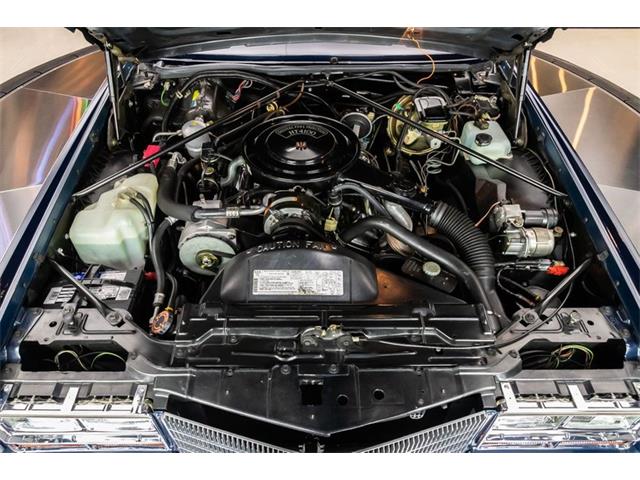 |
Invisible to your average owner, the onboard computer system took another giant leap forward and it's obvious much design work was done with the new engine in mind. For example, as engines were run-in at the factory, calibration data from the actual sensors, in conjunction with exhaust monitoring, allowed each engine to be custom tuned, and parameters (such as EGR response) burned into the respective PROM used in the car itself. As the engine and components aged, the ECM also compensated for wear (known as Memorized Fuel Compensation). And speaking of EGR's, the new ECM now modulates the valve instead of just turning it on and off like it did previously, leading to a smoother running engine.
|
|
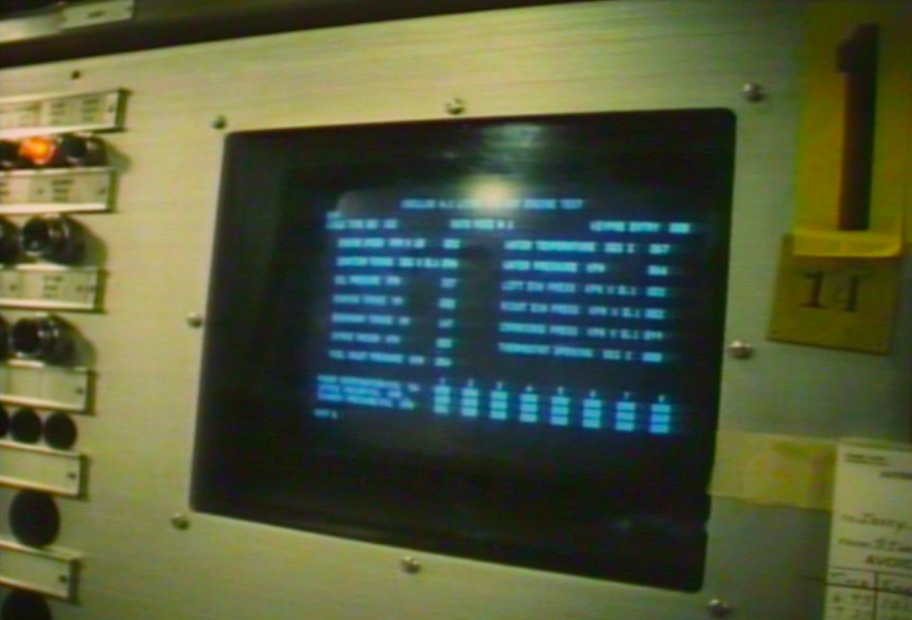 Engine-specific parameter data was programmed into each vehicle's EPROM to optimize performance. |
 New Electronic Climate Control with Outside Temp feature. (84/85 Fuel Data shown) |
In terms of diagnostics, the climate control head display was also expanded from “88” to display “-1.8.8.” The decimal points help differentiate between values and modes. And with three digits, temperature data could be read directly without scaling. The LED indicators above each button now corresponded to the operational status of various inputs. The system now had a “3-pass display”, meaning stored codes are presented twice in succession, followed by a 3rd pass for active codes. No longer did you need to clear all codes to determine active vs. stored. And for anyone who has sat in a hot Eldo on a summer's day calling up diagnostics, the unit now would continue to operate the climate control in the background at the previous set temp.
A new PROM ID command was added, meaning you didn't have to drop the hush panel and pull a cover to get the ID off the chip itself. Switch input tests were revised to use 'standard' controls (previously the cruise switches and rear defrost switch were used as inputs and you had to jump wires if the option wasn't present). Through some clever button pushing, ignition timing could be locked in at 20 degrees & EGR disabled so you could set distributor timing underhood without messing with jumpers. And since the 125 ponies had their work cut out for themselves, the ECM now used TPS data to disengage the AC compressor during heavy acceleration. To account for reduced vacuum from this smaller displacement engine, a new low-vac module was added to light the Brake warning lamp if needed.
There were two generations of ECMs for the '82, each with specific PROMs. A late change updated the 2nd Gen TCC engagement from 48 to 53 MPH, as well as disabled TCC engagement in high altitude conditions.
The updated climate control panel added an Outside Temp feature, doing away with the old mirror-mounted thermometer. And because the ECM does the monitoring for the ECC, it also knows vehicle speed, allowing it to ignore influence of underhood temps in low speed conditions. Since the diesel was still an option...and ECM-less, a different approach was used, built into the climate head itself, to achieve a similar result.
This would mark the third major drivetrain/architecture change in as many years, so it can be forgiven if updates were more evolutionary than revolutionary. On the inside, the 45/45 seats were out and a new 45/50 config was in that would last through '85. This now allowed 3-passengers to sit in front. Under-dash hush panels were now standard regardless of engine choice. A new reminder chime replaced the old unit and now has separate chime patterns for key-in, lights-on, and unbuckled seat belt, as well as driving the Fasten Belts light. No other major interior changes were made.
The exterior, of course, saw a revised grille, park lights, taillights,etc. Cosmetic changes are detailed in the Spotters Guide. Appearance aside, '82 also introduced the locking fuel cap option. This was a cable lock that secured the rear fold-down license plate and was tied into the power door lock system. An override lever in the trunk allowed for unlocking manually. Buick also had a locking cap, but did it in a completely different way with a dash-mounted push button and actuator mounted around the filler neck; very few Riv owners ordered it and little is known in the forums about this option.
The suspension was tweaked for a smoother, quieter ride as well as to account for the lighter engine. The digital speedometer cluster was still offered, and while it looks just like the '81, it's a new part with a different pinout. The MPG Sentinel drops the Active Cyl's button and is now labeled “Fuel Data” but is the same form-factor, however it also adds amber LED indicators to show which function is selected, which requires wiring and circuitry changes to the climate head which drives it. Radio offerings and speakers are again improved. And if the wiring diagrams are to be believed, '82 retains a single Check Engine light like '81, and the ECM pinout is completely different from '83-'85 despite being essentially the same architecture.
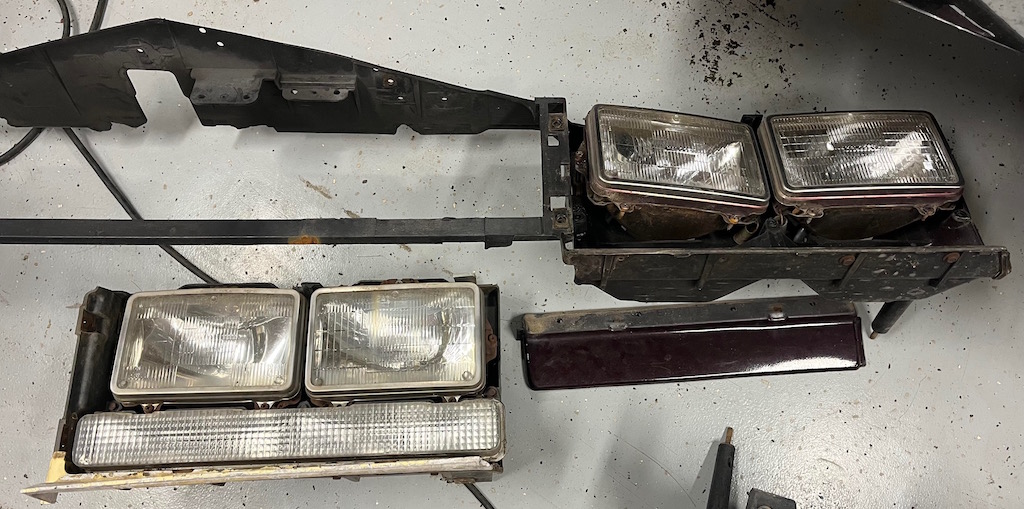 '79 vs '85 Headlight Buckets (with integrated header panel) New 1982 Eldorado Touring Coupe. Click to Enlarge -> |
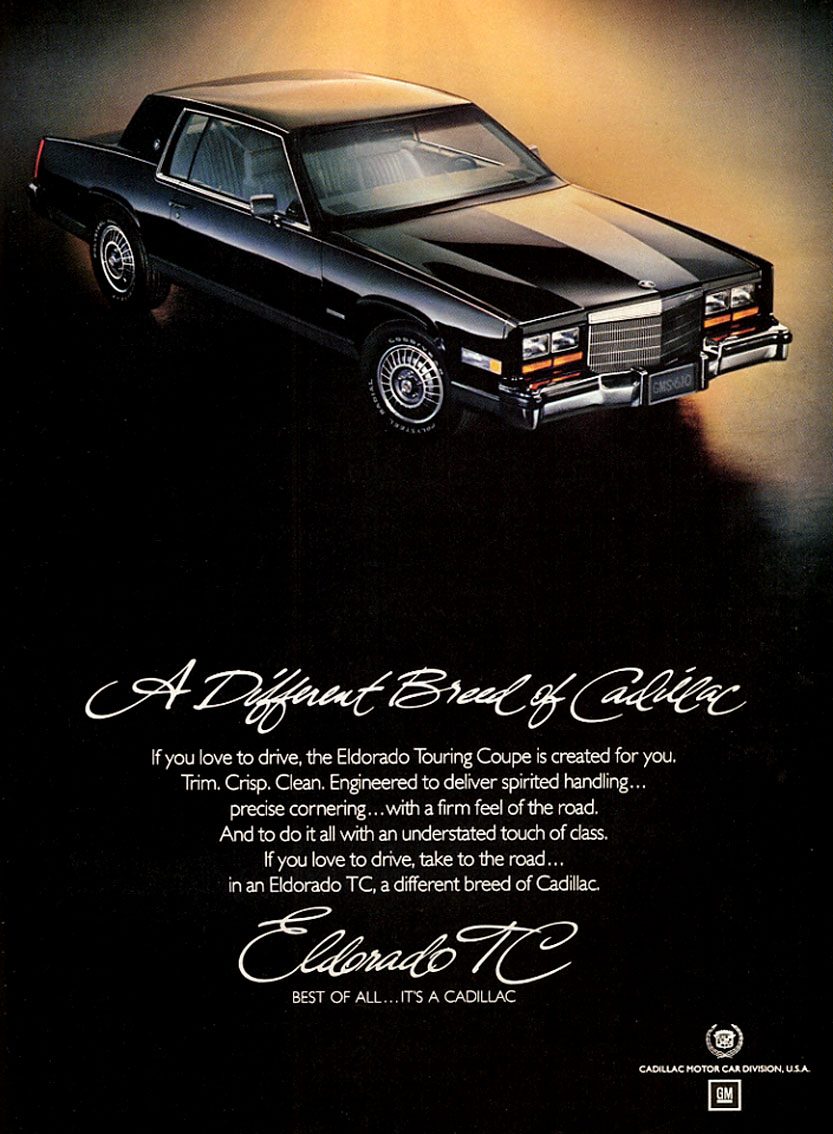 |
Underhood, in addition to the new engine, trans, 2-piece speedometer cable and revised mounting scheme, the individual left and right headlight buckets with steel header plate are dropped for a light weight plastic assembly. The upside is it can't rust or corrode. The downside is an extra wrench-twist to the top fasteners is all it takes to crack one up.
Sadly, the 82's are the most unreliable and the least powerful of all the 79-85's...certain diesel models not withstanding. The one bright-spot for '82 was the introduction of the new Eldorado Touring Coupe. More about that HERE.
| 1983 |
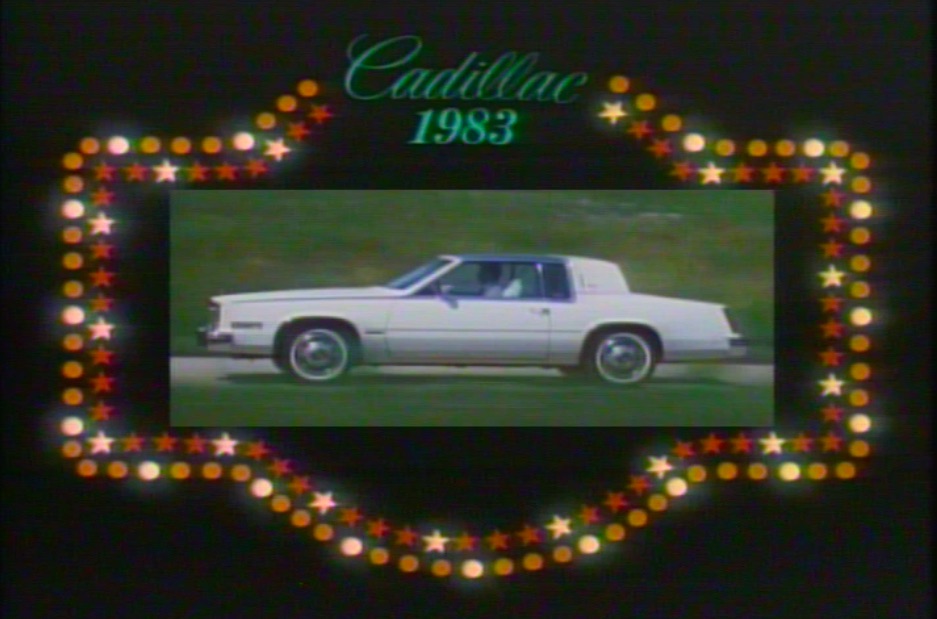 |
The major focus for '83 was on engine improvements, especially reliability. The idea behind the HT4100 was to use an aluminum block for weight savings, while retaining cast iron for the wear items (heads, crank, cylinder liners, etc). Ignoring the teething problems in '82, the real design issue was gasketing not being able to withstand (the dissimilar-rate) thermal expansion of the block as compared to the sleeves and head. This is where the stop-leak tablets came in, which also helped with porosity issues. In addition, changes were made to the cam, front sprocket cover and seals, and even the trans pan to help fight leaks.
For reasons not entirely clear, it appears the ECM pinout and wiring was changed yet again, making '82 unique. The Check Engine light was replaced with a pair of new lights: Service Soon & Service Now.
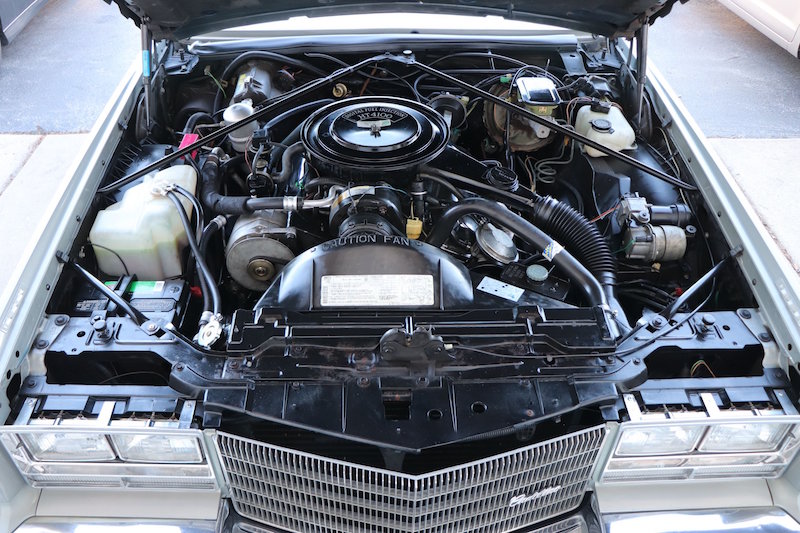 |
Exterior styling changes were few (see Spotter's Guide), and interior updates were limited to new color and upholstery options. However, exterior door hardware changed to more rounded push-buttons with a new internal lever mechanism; I am told the inner door design was modified as well. Horsepower saw a modest bump to 135, and changes to TCC engagement and other engine parameters resulted in improved acceleration and smoother running.
Torsion bars replace the failure-prone rear decklid gas shocks (running change), and a helper spring was available as a retrofit on earlier cars. An industry-first Bose dual-shaft radio was introduced, acoustically tuned to the Eldo. It was a major under-taking....more about that HERE.
 1979-82 Gas Struts |
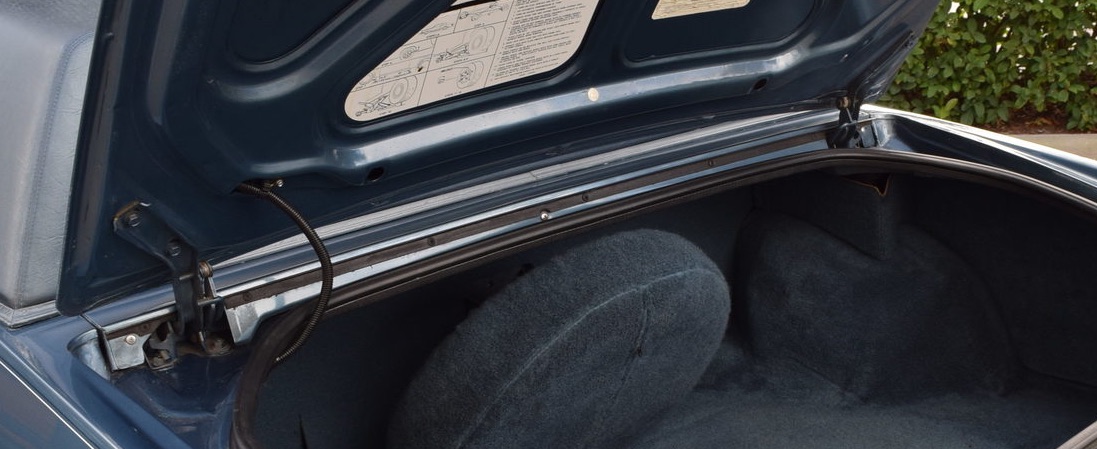 1983-85 Torsion Bars |
 Dealer-Installed Assist Spring |
I'm sure division-focus at the time was on the new '84 front-drivers (production commencing in Dec of '83 and further delayed), planning the new '86 replacement, and stemming the tide of 4100 complaints pouring in from dealers.
| 1984 / 1985 |
The '84/'85 cars are my favorite... There's been 5 years of production up to this point, assembly line techniques are old hat, the EFI system is mature and reliable, the engine and trans are as good as they're going to get, and the chrome-flashed plastic trimmed dash parts (which always looked cheap to me) are finally dropped for matte black trim (upper door panels included).
On that front, the dash receives a major update to accommodate the new Delco 2000 radios, which stand shoulders above the old dual-shaft models in terms of sound quality. The Fuel Data panel is revised to match the width of the climate control panel; inner dash structure is changed for the radio, including AC ducting.
Electrically, a new style bulkhead connector is introduced on the firewall so pinouts and wiring are different than '83, but the circuits themselves remain the same.
Cosmetically, base Eldos have a new ribbed seat pattern (shown below) replacing the old 4-button muffin style, and new interior cloth is available, but the classy Biarritz style remains.
The only '85 improvements (over '84) I've noticed are the addition of a couple harness retention points under the hood, like a hole added to the trans dipstick support bracket to clip the TCC harness to. Or harness routing near the blower motor. Otherwise, the cars are virtually identical.
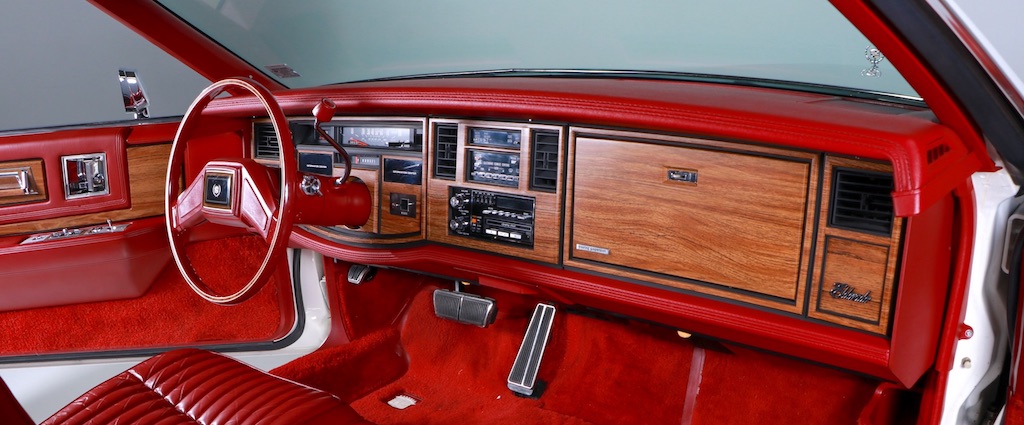 |
With the success of a factory-authorized Riviera convertible in 1982, Cadillac wanted to offer something special for the final Eldos. Available in white, red or blue, the Eldo convertible returned for the final two years of production (which irked many of the '76 "last convertible" owners). 200 pounds heavier, a dash-mounted rocker switch operates the top, and the rear quarter windows are motorized, operated from the driver door control panel (filling the switch position reserved for the memory seat option). Rear speakers were then re-located and are actually a different size. The interior is leather Biarritz upholstery, with a modified (narrower) back seat. 5,600 examples were built over the 2-years. For further info on ASC conversions (including the Riv), checkout this Hagerty article.
If you prefer the coupe, late '85 saw the offering of a Commemorative Edition, featuring a custom two-tone interior, gold wheel medallians, and 1979 taillights.
All '84/'85 models get the new-style light weight cat converters. And to make service parts identification (and paint codes) easier, a SPID label was introduced, added to the underside of the deck lid. 1984 models can be ID'd by chrome valve covers while '85s are black ribbed cast aluminum, with improved sealing and longer bolts. Fender badges are dropped for both. At least one internet source claims there were block upgrades after VIN FE623772 on Eldo; I have been unable to confirm.
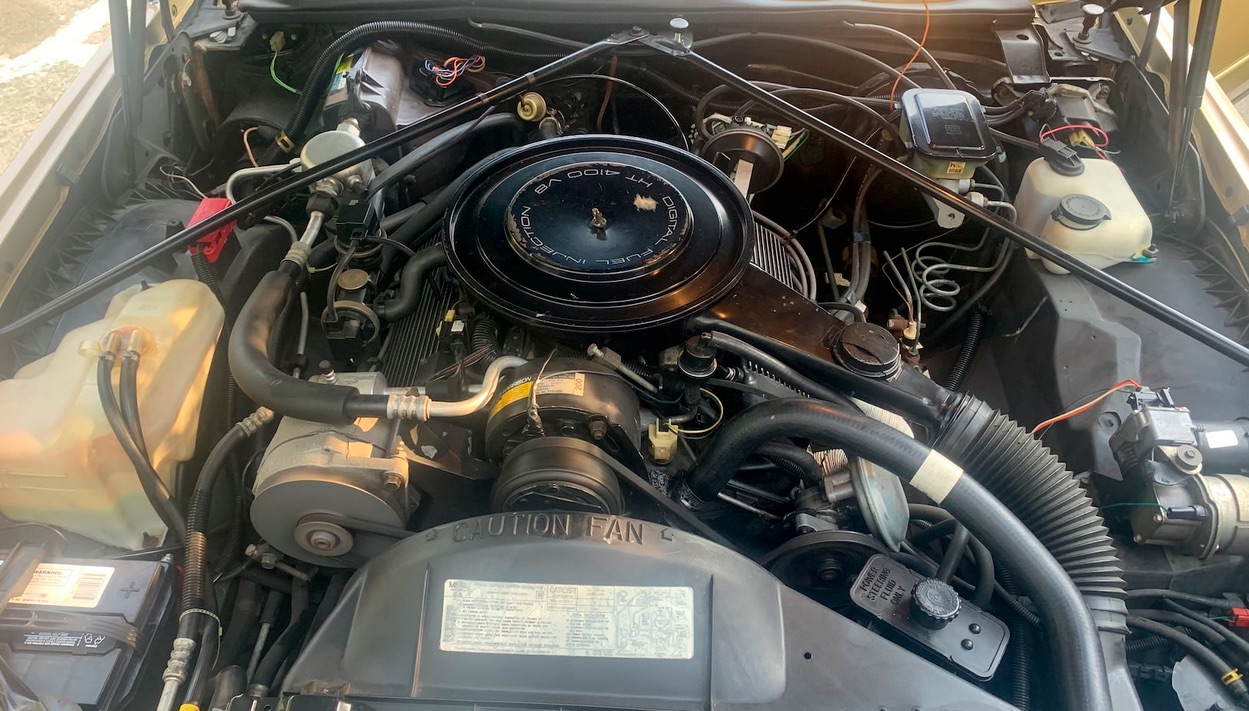 1985 shown with ribbed aluminum valve covers & new air cleaner decal. '84 has silver ring on lid; black stamped covers. |
Despite the HT4100 issues, many 1984 and '85 models seem to have survived, and the updated maintenance intervals for oil and coolant changes, along with a list of factory updates to both the engine and software, did make a noticeable improvement. Mileage is quite good for these cars, though they are under-powered. This wasn't a huge concern in 1985 when grandma would take the car to Bingo, and the imports were touting double-digit horsepower. In today's environment it's a little more problematic. An Engine Swap can improve things there.
In terms of collectibility, these cars have been a good value for a number of years, but it looks as though that may be coming to an end. The collector car market is fickle, especially post-COVID, and nice examples have now shifted into the $20k+ range.
Return to Main Page Comments? Corrections? Contact Webmaster Cory Heisterkamp 2022
